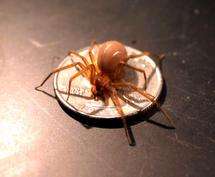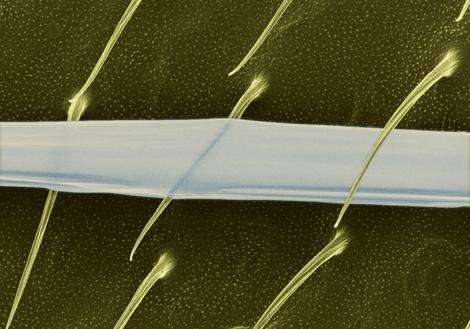Spider's super-thin ribbons key to silk tech

(Phys.org) —The silk of a spider feared for its venomous bite could be the key to creating new super-sticky films and wafer-thin electronics and sensors for medical implants that are highly compatible with the human body.
A team of scientists from Oxford University and The College of William and Mary (USA) studied the brown recluse spider (Loxosceles recluse), which produces super-thin ribbons of silk as opposed to the round fibres typically spun by spiders. The researchers report in the journal Advanced Materials this week how, in a world-first, they were able to reel and examine the unique properties of the brown recluse's silk ribbons.
While the silk ribbons have the outstanding strength and toughness of standard spider silk, their flat structure makes it possible to study the material's molecular structure in great detail and investigate what gives it its strength. The team found that the extreme thinness of the ribbons, which are up to 10 nanometres wide and only a few tens of nanometers thick, combined with its stiffness and the ability to adapt to the shapes of surfaces is what gives it its unprecedented adhesive properties. The team also found that the surface of the silk ribbons is covered with tiny, dot-like 'bumps' that the research team suspects further enhance adhesion.
'The enigmatic ribbon structure of these threads provides us with a window into spider silk in its simplest form,' said Professor Fritz Vollrath of Oxford University's Department of Zoology, an author of the study. 'All other silks are round, rope-like aggregates made up of many nano-scale filaments. This makes it virtually impossible to study in great detail the molecular structure of the silk itself, and the fundamentals for its great toughness.'

Professor Hannes Schniepp of The College of William and Mary, lead author of the report, said: 'We were able to modify an atomic force microscope to measure the rigidity of a single recluse fibre and discovered that this ribbon – only a few molecules thick – not only displays the great properties of other silks but allows us to probe its structure in unprecedented detail.'
This discovery is expected to have implications for the development of new super-sticky cling films and also for the manufacture of thin-film electronic devices, which might even be implanted as sensors in the human body – where silks are highly valued for their outstanding combination of great mechanical strength and excellent biological compatibility.
More information: onlinelibrary.wiley.com/doi/10 … /adma.201302740/full
Journal information: Advanced Materials
Provided by Oxford University



















